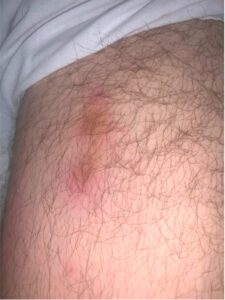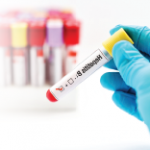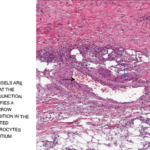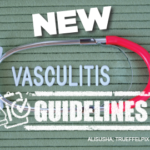
FIGURE 1: The patient presented with an erythematous, tender, nodular rash overlying both of his lower extremities and lower abdomen. (Click to enlarge.)
Polyarteritis nodosa (PAN) is a necrotizing vasculitis, predominantly involving medium-sized arteries, that causes systemic disease, and, less commonly, cutaneous-limited disease. The population prevalence for PAN ranges from 2 to 33 per million.1-3 Estimates vary due to the increased recognition and classification of other forms of vasculitides over time and variation in the regional prevalence of hepatitis B virus infection, a disease that is closely associated with PAN. Cutaneous PAN accounts for approximately 4% of all cases of PAN.4
Here, we present a case of cutaneous PAN with antecedent group A Streptococcal infection, treated with non-steroidal anti-inflammatory drugs (NSAIDs), colchicine, prednisone and antibiotics.
Case Description
A 22-year-old man with a past medical history of gastric sleeve surgery and active tobacco use presented with a painful rash and polyarthralgia. His rash had started four weeks before on the sole of his left foot and spread in an ascending manner, involving both lower extremities, his groin region and abdomen. He developed swelling and pain in his left knee two weeks before and pain in his bilateral elbows two days before presentation. He was febrile up to 102.8ºF (39.3ºC) the first night of his hospitalization, although the patient did not mention having a fever while at home.
The patient stated that a punch biopsy of his left calf rash had been performed by a community dermatologist a few days earlier. The tissue sample contained a muscular blood vessel associated with a mixed inflammatory infiltrate including neutrophils and eosinophils; fibrinoid and basophilic material within the lumen of the blood vessel and fibrosis were noted. The interpretation was of medium vessel vasculitis, suggestive of PAN, with differential diagnosis including anti-neutrophil cytoplasmic antibody (ANCA) associated vasculitis and vasculitis caused by another rheumatic disease, less likely erythema induratum. The patient had been directed to come to the hospital for further evaluation.
The patient did not recall any preceding acute illnesses, vaccinations, animal or insect bites, travel or sick contacts. He denied any history of skin, joint, gastrointestinal, autoimmune or sexually transmitted diseases. He reported being predominantly indoors for work, though he occasionally did yard work at home. He had been taking NSAIDs, acetaminophen and tramadol for his symptoms with limited effect; he otherwise did not regularly take medications.



